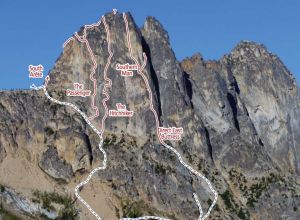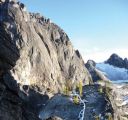The Passenger, South Early Winters Spire IV 5.12a |
||
Washington Pass, Washington, USA | ||
| ||
|
Avg time to climb route: 5-8 hours
Approach time: 1.5-3 hours Descent time: 1.5-3 hours Number of pitches: 9 Height of route: 800' Overview
The Passenger is widely considered the Astroman of Washington Pass, or even of the whole state. It offers exceptional and sustained thin crack climbing with occasional steep face climbing that never lets up until the final pitch. Nearly all of the pitches are good and the rock is clean and solid. The Passenger is a mega-classic and a must-do for anyone up to the grade. It is a sustained climb that isnít quite as hard as the grade suggests. While there is plenty of climbing in the 5.10d-5.11b range, the more difficult sections are often short, powerful, and feel like boulder problems. Photos
- View all 2 photos of The Passenger as: Thumbnails | Slideshow
Climber Beta on The Passenger
Find other routes like
The Passenger
Route History
First climbed by Bryan Burdo, Pete Doorish and Greg White in 1991. Burdo had long stared at the massive south face of South Early Winters Spire, but it wasnít until 1990 that White and Burdo went to have a look. The pair climbed ground up about a half way up the wall, free climbing with some mixed aid, cleaning and equipping the route like a sport route. On person would lead the pitch by aid, free or whatever means necessary, then the pair would brush, scrub and bolt the pitch as needed before a red point attempt was made. Burdo then returned the following year and red pointed the route in a long day with Doorish. On the final push, the pair led the upper half onsite, barely finishing before dark. Burdo said they wanted to continue straight up through the steep roofs on the final pitch but were forced left because of fading light. He believes the route should go that way for a direct finish. That finish has been done and is getting more popular but the final classic leftward traverse remains the standard.Burdo named his route The Passenger because of the routeís proximity to the Highway and the constant view of the hairpin turn on Highway 20. The Passengerís neighbor, The Hitchhiker, establish by Burdo more the ten years later, derives its name from the same theme. The name The Passenger was also inspired by a song Burdo liked at the time. After climbing The Passenger, Burdo changed his opinion about establishing climbs. Though he spent a lot of work cleaning and equipping The Passenger, he produced a classic that everyone loved and he decided all climbs should be at a similar quality standard. The Passenger was also one of the earliest routes where Burdo used a roto-hammer. Now he is, of course, famous for establishing hundreds and hundreds of sport routes in the state, especially at exit 32, exit 38 and around Mazama. Strategy
This route is more famous than it is climbed. The 5.12- grade is slightly misleading. While it is difficult and sustained, it mostly sustained in the 5.10+-5.11a/b range with short 5.12- and 5.11c sections. The 5.12a crux is a 3-4 move V5 boulder problem with a bolt at your head. The 5.11c Pitch 2 is also mostly 5.10d/5.11a with only a couple body lengths where the climbing is more challenging. While you can pull through the hardest sections of the route on gear, you canít pull through all the 5.11a/b sections and they are plentiful. Be solid at the grade.While older guide books suggest fixing the first few pitches on Day 1 and firing the rest the next day, the truth is nearly everyone up to the grade climbs this route in a day. For 5.12 climbers, the route climbs quickly due it its mostly straightforward nature and a few bolted belays. The route is warm and gets sun most of the day, as a result The Passenger has one of the longest seasons at Washington Pass, and is one of the earliest and latest climbable routes in the area. This makes The Passenger a poor choice if temps in Mazama are above 90 degrees, as youíll be sweating through the cruxes during the hottest time of the day. The Passenger does dry out quickly after a rain or storm. If there are other parties, passing will prove difficult and if you fear they might be a lot slower, then you might want to consider climbing the nearby Hitchhiker. Most climbers find the hairpin approach is unpleasant enough that theyíd rather walk the extra distance with similar elevation gain but on nicer trails rather than the scree-covered approach from the Hairpin. A good plan could be hike from Blue Lake, rack up, and leave your gear at the base of the South ArÍte, hike ten minutes down a loose gully to the start of The Passenger in your rock shoes and when you finish descending the South ArÍte, your gear is ready to cruise down to Blue Lake Trail- head. You can also hike and scramble up the base from the hairpin, leave your shoes at the base and descend the South ArÍte and scramble back down to your gear and reverse your approach to the hairpin. Retreat Storm
Rappelling the route would be relatively straightforward. Once past Pitch 4, the fixed anchors disappear and you would have to leave gear to retreat. Having two ropes means leaving less gear. Due to The Passengerís location on the south face of South Early Winters Spire, it dries very quickly after a rain or snow storm and is generally sheltered from the worst of the wind.
Everything You Need to Know About
Washington Pass
Search the internet for beta on
The Passenger
|
Other Routes on South Early Winters Spire
|






